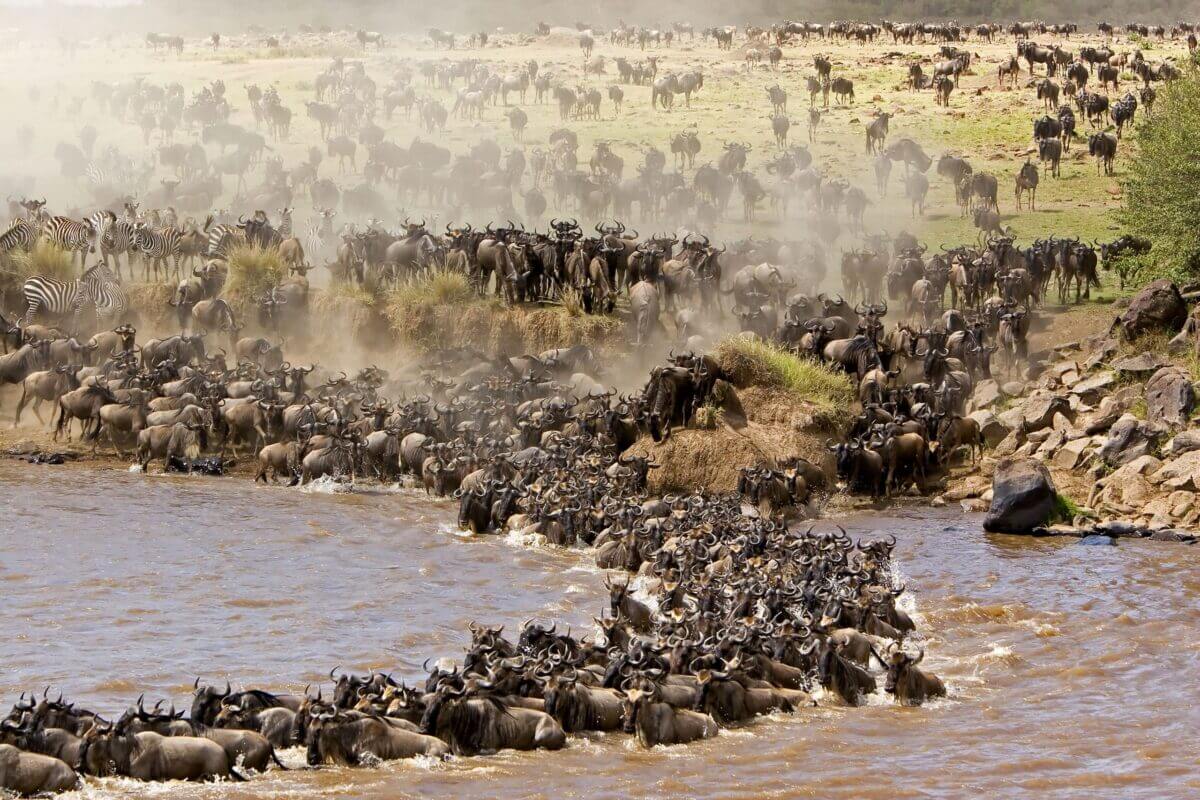Hidden stories of Tanzania’s Great Migration

Each year, over two million wildebeest, zebras, and gazelles journey between the Serengeti and the Masai Mara, following the promise of fresh pasture and favorable conditions.
This phenomenon is known as the Great Migration, a large-scale movement that plays a vital role in the ecosystem and is a major draw for wildlife tourism.
Ready to witness something unforgettable?
This guide walks you through some captivating aspects of the Great Migration and shares practical tips on the best time to go and how to make the most of it.
What sets the Great Migration in motion
The Great Migration is undoubtedly the largest animal movement on Earth.
Each year, over 1.2 million wildebeest and 300,000 zebras—accompanied by gazelles and even small mammals—move across the Serengeti-Mara ecosystem in search of better conditions. Along the way, they face harsh weather and constant threats, above all, predators. Lion prides, in particular, pose a serious risk to calves and weaker animals.
But what drives these animals to cover such vast distances?
It all comes down to survival. Their movements are guided by instinct and the seasonal rains, which are crucial for the growth of fresh grass, their primary food source. When an area becomes dry or overgrazed, the herds must move on.
In addition, certain locations along the route, like the Serengeti plains, offer ideal conditions for calving. Open landscapes make it easier to detect predators, while rich pastures provide the nourishment needed for new life.
Now, let’s take a closer look at some of the most widespread myths about the Great Migration.
Migration myths and facts
Now that we’ve clarified why these animals migrate, it’s time to debunk some common myths about this fascinating phenomenon. Let’s take a look:
- it doesn’t only happen in July: the Great Migration isn’t limited to the dramatic Mara River crossing in July. It’s a continuous cycle that unfolds throughout the year. Each season offers breathtaking moments, from calving in January and February to large-scale movements between June and October.
- It’s not just in the Serengeti: the migration extends beyond Tanzania’s Serengeti into Kenya’s Maasai Mara, as well as other areas like the Ndutu region in Ngorongoro, which plays a key role during the calving season.
- It’s not just about wildebeest: as mentioned earlier, the migration also involves around 200,000 zebras and thousands of Thomson’s and Grant’s gazelles, all moving together in a remarkable display of cooperation and survival.
Do wildebeest really follow the rain?
Yes, but not in a perfectly predictable way. Their movements are driven by a collective instinct to find the best grazing and access to fresh water.
Seasonal rains play a major role in shaping their path, but predators and natural barriers can also influence where the herds go.
The Calving season
Among the most moving and captivating moments of the Great Migration is the Calving season, when females give birth to their young.
Each year, between January and February, this extraordinary event takes place in the Ndutu region, located between the Serengeti and the Ngorongoro Conservation Area. Around 500,000 wildebeest calves are born within a short time, surrounded by endless plains, fresh grass, and vital water sources.
Wildebeest are the true stars of this season, thanks to the sheer number of births concentrated in just a few weeks. Zebras and gazelles also give birth during this time but in significantly smaller numbers.
Wildebeest are at the heart of the Great Migration, as their sheer numbers and rapid reproduction are essential to both the balance of the ecosystem and the continuation of this natural phenomenon.
Witnessing the birth of hundreds of calves is undoubtedly one of the most powerful experiences a safari can offer. However, this high concentration of newborns also attracts predators: hyenas, lions, and cheetahs are drawn to the presence of these vulnerable young animals.
During the Calving Season, the delicate balance between predator and prey unfolds in its most intense form.
Photographing the Great Migration ethically
If you’re passionate about photography, the Great Migration offers an unforgettable opportunity to capture dramatic, breathtaking scenes.
However, it’s essential to approach this activity with full respect for the environment and the animals’ sensitivity. That’s why keeping a proper distance is crucial to avoid disturbing the delicate balance between wildlife and nature.
In this context, the guidance of experienced local experts is key to ensuring a mindful and responsible photo safari.
Your front-row seat to the Great Migration
Planning a safari to witness the wonder of the Great Migration?
Zohar African Safaris offers a variety of tailor-made options to experience this natural spectacle authentically and engagingly.
The Great Migration Safari – 7 days (April–May) is ideal for observing the herds in the Central Serengeti during a less crowded season, offering a well-rounded Tanzanian wildlife experience.
Another great option is the Great Migration & Mara River Crossing – 8 days, perfect for witnessing the river crossing as the herds face the rushing waters of the Mara River.
Both packages can be customized to suit your preferences, ensuring a truly unique and unforgettable Great Migration experience.
Choose your route and get ready to experience the Great Migration like never before.
